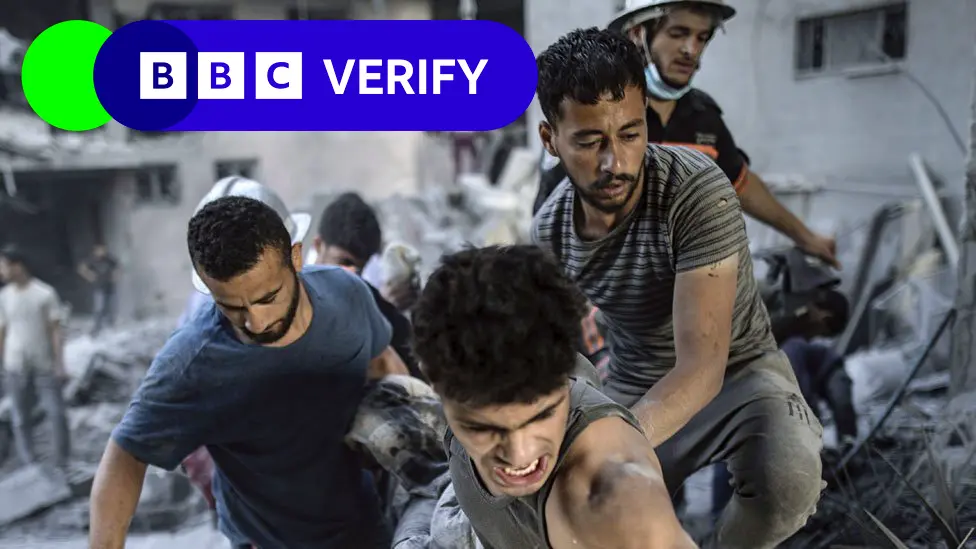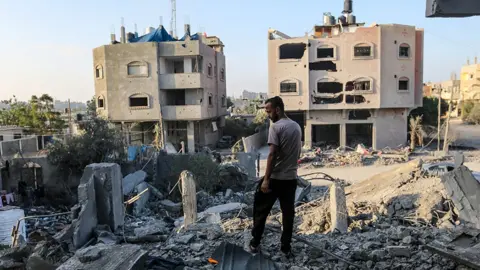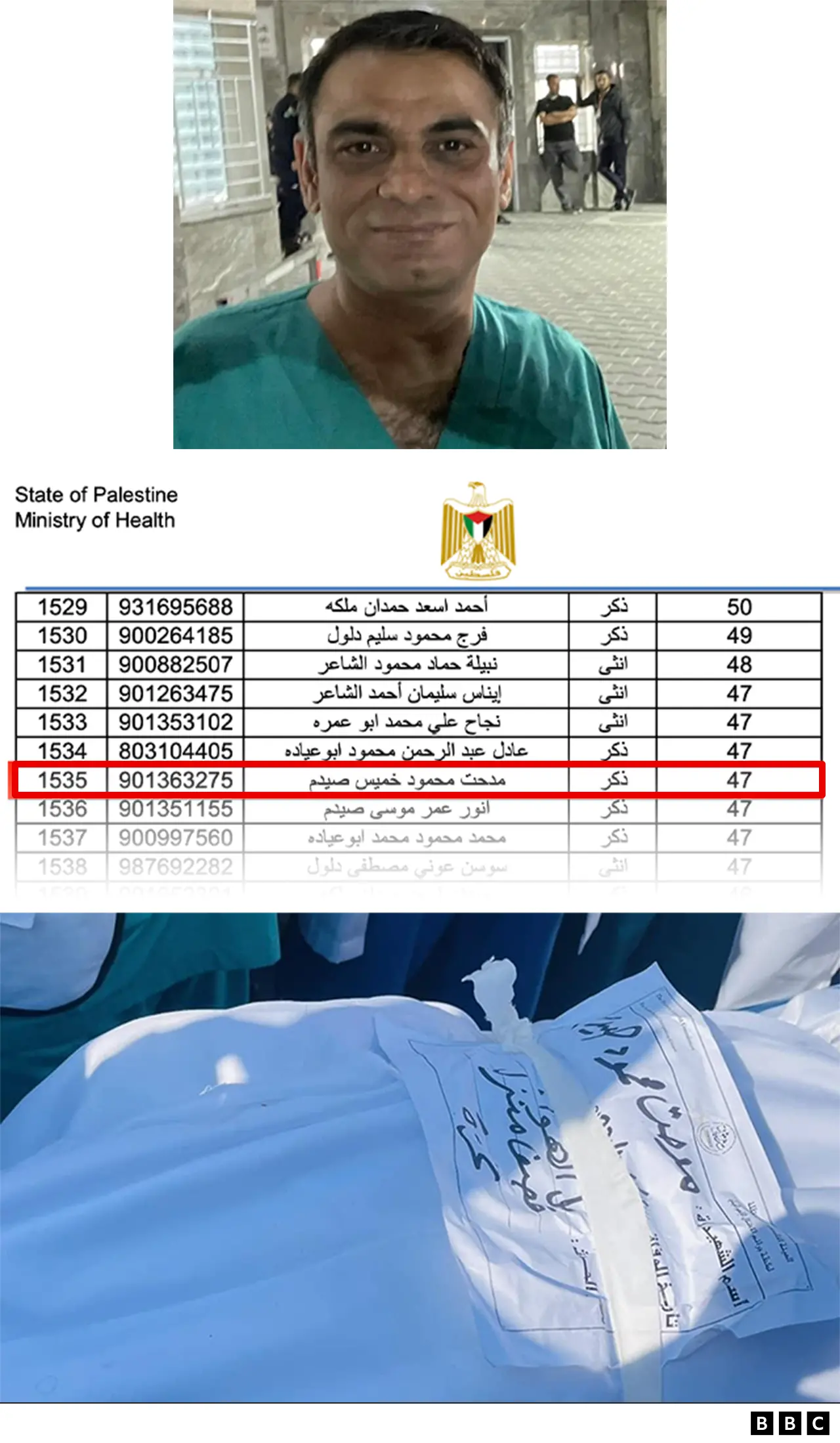How the dead are counted in Gaza
 EPA
EPAIn any warzone, counting the dead is a challenge. Gaza is no different.
As battles there intensify, the chaotic situation - with bombardment by Israeli forces, on-the-ground fighting, communications blackouts, fuel shortages and crumbling infrastructure - makes getting accurate information on the numbers of people who have died extremely demanding.
And Palestinian officials have said there are now "significant difficulties" in obtaining updated information because of the interruption of communications in the Gaza Strip.
The Hamas-run health ministry is Gaza's official source for death numbers - which it updates regularly. On Monday evening, it said 11,240 people had been killed, including 4,630 children, since the Hamas attacks on Israel on 7 October which prompted the current war.
The figures have been publicly doubted by Israel. The number of those killed in the attacks in Israel, meanwhile, was initially put at 1,400 by Israeli authorities but was later revised down to about 1,200.
US President Joe Biden has said he has "no confidence" in the Gaza statistics. But international organisations, such as the UN's World Heath Organization (WHO), have said they have no reason to disbelieve them.
The BBC has been looking in detail at how the casualty figures for Gaza are counted.
The figures
The health ministry in Gaza reports a regular death total on social media, with an additional breakdown of the number of women, children and the elderly who have been killed. The figures do not give the cause of death, but describe the dead as victims of "Israeli aggression".
The ministry also gives figures for the injured and the missing. Some of the bodies remain trapped under piles of rubble, says the Palestinian Red Crescent.
Health ministry officials say the death figures are recorded by medical professionals before being passed on to them and the figures only include people recorded dead in hospital. The figures do not distinguish between military and civilian deaths. And, because they do not take into account those who died at the scene of blasts whose bodies have not been found, or buried immediately, they may be an undercount, Gazan officials say.
That point was amplified by the Biden administration last week, when a senior US official said the death toll was likely to be greater than the numbers being reported.
"We think they're very high, frankly," Barbara Leaf, assistant Secretary of State for Near Eastern Affairs, told a House Foreign Affairs Committee, "and it could be that they're even higher than are being cited."
It stands in stark contrast to the view of Mr Biden himself, who, on 25 October, said he had "no notion that the Palestinians are telling the truth about how many people are killed."
However, he did not provide any evidence for his scepticism.
A day after Mr Biden's dismissal of the numbers, the health ministry in Gaza provided more information, publishing an extensive list of names of all those who had been killed between 7 and 26 October. The list included more than 6,000 full names with their ages, sex and ID numbers.
How was it compiled? The BBC has spoken to people involved in gathering and organising the data as well as an academic who has checked for duplicates on the list of names.
We have also spoken to an independent research group, Airwars, which is in the process of matching deaths it has investigated to names on the health ministry's list, and the UN - which has assessed death figures in Gaza during previous periods of conflict.
How the dead are counted
 Getty Images
Getty ImagesHealthcare workers like Dr Ghassan Abu-Sittah, a Médecins Sans Frontières plastic surgeon based in London who has been treating people at hospitals in Gaza City, are key to recording those figures.
He says the hospital morgue records deaths after confirming the identity of the dead person with their relatives.
The number of deaths registered so far, he believes, is far fewer than those that have actually occurred. "Most of the deaths happen at home," he says. "The ones we could not identify, we did not record."
However, once a body is found, it "has to be taken to the hospital to be recorded", says a spokesperson for the Palestinian Red Crescent.
To examine the health ministry's list, the BBC cross-referenced names included on it with the names of dead people who had appeared in our reporting. One of those deaths the BBC reported was Dr Midhat Mahmoud Saidam, who was killed in a strike on 14 October. The BBC spoke to his former colleagues.
Satellite imagery analysis carried out by the BBC showed damage to the area where he lived around the date of his death. An image posted on social media shows a body bag with his name and details written on it.

Similar work, but on a larger scale, is being done by Airwars. As part of its work investigating civilian deaths, it has matched names of the dead on the health ministry list with areas that have been bombed. So far, Airwars has found 72 names on the ministry's list in five of the areas it has investigated, including Dr Saidham's.
Its investigation also found 23 of his family members had also died and all were recorded on the health ministry list.
Scrutinising the stats
The BBC also spoke to the UN and Human Rights Watch - both of which said they had no reason to disbelieve the figures released by the health ministry in Gaza.
The UN relies on the health ministry as a source for casualty figures in the area.
"We continue to include their data in our reporting, and it is clearly sourced," it said in a statement. "It is nearly impossible at the moment to provide any UN verification on a day-to-day basis."
Others who have scrutinised the health ministry's figures include economics professor Michael Spagat, from Royal Holloway, University of London - who chairs the charity Every Casualty Counts which studies death tolls in wars.
 Getty Images
Getty ImagesHe says he and a colleague found just one duplicate entry in the health ministry dataset - that of a 14-year-old boy.
However, one discrepancy remains hotly contested - that of the death toll after a blast at al-Ahli hospital in Gaza City on 17 October. The health ministry said 500 people had been killed, and that figure was later revised down to 471. An assessment by US intelligence was lower, "probably at the low end of the 100-to-300 spectrum". Israel's military cited the al-Ahli figures as the basis for a claim that the Gaza health ministry "continuously inflates the number of civilian casualties."
The BBC has made repeated attempts to contact the health ministry in Gaza, but has been unable to get a response so far.

More on Israel-Gaza war
- Follow live: Latest updates
- From Gaza: ‘So crowded we can’t even sleep on our backs’: Gaza shelters at breaking point
- From Israel: How much closer is Israel to its goal in Gaza?
- Explained: The faces of hostages taken from Israel
- History behind the story: The Israel-Palestinian conflict

Prof Spagat has also looked back at previous conflicts, and found that health ministry figures in Gaza have held up under past scrutiny.
In an analysis of health ministry death figures from the Israel-Gaza conflict in 2014, in which Gaza was bombed, and a separate record of death figures from that same year collated by Israeli human rights organisation B'Tselem, Prof Spagat found overall consistency in the reported figures.
The ministry of health said 2,310 Gazans had been killed in 2014, while B'Tselem counted 2,185 deaths. The UN said 2,251 Palestinians were killed, including 1,462 civilians and Israel's foreign ministry said the 2014 war killed 2,125 Palestinians.
Discrepancies such as these are "fairly normal" says Prof Spagat, as some people may have died in hospital for reasons subsequently shown to be unrelated to violence in conflict.
Ola Awad-Shakhshir, president of the Palestinian Central Bureau of Statistics, in Ramallah, in the occupied West Bank, receives regular updates of deaths from Gaza.
Ms Awad-Shakhshir says that Israel's interior ministry effectively controls ID numbers for newborn babies born in Gaza and the West Bank - the same ID numbers that appear on the Hamas-run health ministry's register of recorded deaths.
The Israeli Population Registry Office holds files that match those in Gaza and the West Bank.
When the BBC approached a spokesperson for the Israel Defense Forces about why they have cast doubt on the Gazan death figures it said the health ministry was a branch of Hamas and that any information provided by it should be "viewed with caution". But it did not provide any evidence of inconsistencies in the data released by the health ministry.
We also asked the Israeli prime minister's office about how the numbers of Israelis killed on 7 October by Hamas were recorded. It did not answer that question, however in recent days Israel has revised down the number of people killed during the attack to about 1,200, from the earlier figure of 1,400.
Foreign Ministry spokesman Lior Haiat said the revised number was because many bodies were not immediately identified after the attack, and "now we think those belong to terrorists... not Israeli casualties".
The Israeli government has not published a detailed list of the civilian casualties although some Israeli media outlets have assembled such lists with names, ages and locations of deaths.
Israel's police says more than 850 bodies of civilians have been identified - work is continuing to try to identify remains using specialist forensic techniques.
There is a public list of the Israeli soldiers killed so far that includes 48 who have died in the fighting inside Gaza.
